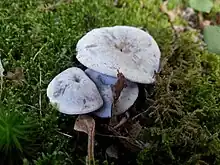| Cuphophyllus canescens | |
|---|---|
 | |
| Cuphophyllus canescens, Pennsylvania | |
| Scientific classification | |
| Domain: | Eukaryota |
| Kingdom: | Fungi |
| Division: | Basidiomycota |
| Class: | Agaricomycetes |
| Order: | Agaricales |
| Family: | Hygrophoraceae |
| Genus: | Cuphophyllus |
| Species: | C. canescens |
| Binomial name | |
| Cuphophyllus canescens | |
| Synonyms[2] | |
| |
Cuphophyllus canescens is a species of agaric (gilled mushroom) in the family Hygrophoraceae, known from North America. In its wide sense (including the recently separated C. atlanticus) it has been assessed as globally "vulnerable" on the IUCN Red List of Threatened Species.[1]
Taxonomy
The species was first described from North Carolina in 1942 by American mycologists Alexander H. Smith and Lexemuel Ray Hesler as Hygrophorus canescens. It was transferred to the genus Cuphophyllus by French mycologist Marcel Bon in 1990, at which time it was thought also to occur in northern Europe.[3] As a result of molecular research, based on cladistic analysis of DNA sequences, Cuphophyllus canescens has, however, been found to be restricted to North America.[4]
Similar species
Cuphophyllus atlanticus is very similar, but is said to have a pure gray to bluish gray cap and (microscopically) larger, subglobose spores.[4]
See also
References
- 1 2 Jordal J. "Cuphophyllus canescens. The IUCN Red List of Threatened Species". Retrieved 2022-06-02.
- ↑ "Cuphophyllus canescens". MycoBank. International Mycological Association. Retrieved 2012-01-10.
- ↑ Boertmann D (2010). The genus Hygrocybe (2nd ed.). Copenhagen: Danish Mycological Society. p. 200. ISBN 978-87-983581-7-6.
- 1 2 Jordal JB, Larsson E (2021). "Cuphophyllus atlanticus (Hygrophoraceae, Agaricales) — a new sister species to the North American C. canescens". Agarica. 42: 39–48.
